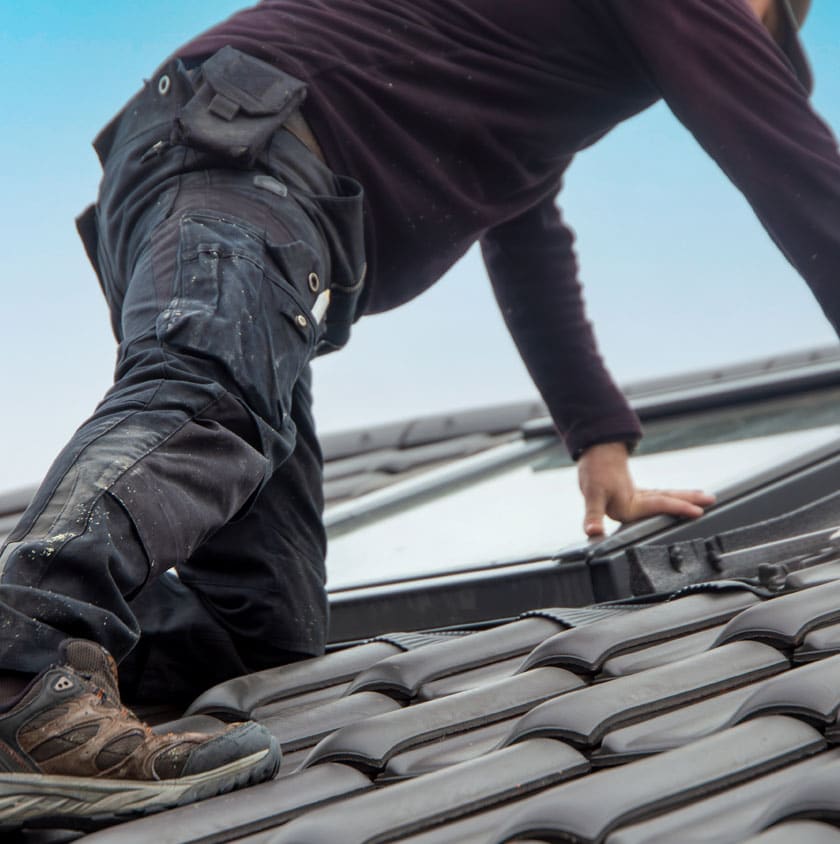
Roofer Insurance
Compare Roofer Insurance Quotes
- Complete one short form
- Quickly compare quotes
- Find a great deal today!

Compare insurance quotes from UK’s leading roofer insurers including:
Why Compare Roofing Insurance Quotes At SimplyQuote.co.uk?
Comparing roofer insurance gives you the chance to find cover that actually fits the way you work — whether you’re fixing a leak on a domestic roof or managing a full re-roof on a commercial site.
At SimplyQuote, we partner with Quotezone to provide access to quotes from a panel of trusted UK tradesman insurers. You fill out your details once, and we do the hard work — matching you with insurers who understand the risks that come with roofing.
You’re working at height, on scaffolding, near expensive property — often in unpredictable weather. One dropped tile, loose ladder, or stray bit of debris can lead to thousands in claims. But not every policy is built for that. Comparing ensures you get the right public liability limit, tool cover, and (if needed) employer’s liability — all tailored to the jobs you take on.
You won’t be chased by salespeople. No endless phone calls. Just quotes you can compare quickly, with cover built for your trade.
What Do I Need to Get a Quote?
To get a roofer insurance quote, you’ll need to provide some basic details about your work, your business setup, and the type of cover you’re looking for.
It usually takes less than five minutes. You’ll be asked about:
- Type of roofing work you do – Flat, pitched, domestic, commercial, heritage, or specialist materials
- Business structure – Sole trader, partnership, or limited company — and whether you use subcontractors or labourers
- Working height – This affects your risk profile and premium; some policies have height limits
- Tool and equipment use – Especially if you carry power tools, scaffolding, or safety equipment that needs insuring
- Public liability level required – £1M, £2M, £5M or £10M depending on client demands and job size
- Turnover and postcode – Helps insurers assess your exposure and local risk levels
- Optional extras – Like tool cover, employer’s liability, personal accident, or contract works insurance
- Claims history – Any past claims or incidents can affect pricing or acceptance
It’s designed to be quick, but accurate input matters. The more specific you are, the better your quotes will reflect how you actually work.
Does Roofer Insurance Cover Working At Height?
Yes, roofer insurance can cover working at height — but most policies include a maximum height limit, and you’ll need to declare it during the quote process.
Failing to do so could invalidate your cover.
Insurers often set a maximum allowable height for roofing work. This is commonly:
- 10 metres – Standard for domestic or low-level commercial work
- 15 metres – Sometimes available for more advanced or commercial projects
- Over 15 metres – May require specialist insurers or bespoke underwriting
These height limits exist because the risk of serious injury or property damage increases the higher you go. If you don’t specify that you regularly work above these limits, your claim could be denied — even if the work was otherwise covered.
Scaffolded roof replacements, industrial units, or multi-storey buildings often exceed standard height limits. So if your work regularly involves higher structures, be clear from the outset. Most comparison tools (including SimplyQuote) will ask for your working height during the quote process.

Why Do I Need Roofer Insurance Cover?
Roofing comes with high-risk work by default — and roofer insurance protects you if something goes wrong. Whether it’s a falling tile, a third-party injury, or damage to a client’s property, you could be personally liable without cover.
You’re working at height, often on scaffolding, exposed to the weather, and sometimes in busy public areas. It only takes one misjudged move — a dropped tool, loose ridge tile, or unsecured ladder — to cause serious damage or injury.
Public liability insurance helps cover compensation claims if you cause injury or damage during a job. If you rely on your tools to earn, tool cover helps you bounce back after theft or damage. And if you fall, trip, or get injured on site, personal accident cover can help cover lost income.
And it’s not just about risk — it’s about reputation. Most building contractors, housing developers, and domestic clients will ask for proof of insurance before they even let you start.
What Insurance Do Self-Employed Roofers Need?
Most self-employed roofers need at least public liability insurance, tool cover, and personal accident protection.
If you ever bring in help, even casually, you may also need employer’s liability by law.
Here’s what a typical self-employed roofer will want to include:
- Public liability insurance – Covers injuries to others or damage to property caused during your work. If a roof tile drops and cracks a conservatory — this is what helps pay for the damage.
- Tool cover – Roofing tools are expensive and essential. Tool insurance helps replace them if they’re stolen or damaged — especially useful if you store gear in your van.
- Personal accident insurance – If you get injured on site and can’t work, this can help replace your income while you recover.
- Employer’s liability insurance – Not always needed if you work alone. But the moment you hire labourers or rope in a mate, it may become legally required.
Optional extras like legal expenses or contract works cover might be useful too — especially if you take on larger builds or quote for site-based work.

Does Roofer Insurance Cover Subcontractors Or Hired Help?
Roofer insurance doesn’t automatically cover subcontractors or labourers — and if you haven’t declared them, your policy may not pay out if something goes wrong. It all comes down to how those workers are classified.
Labour-only subcontractors
If someone works under your direction, uses your tools, or follows your hours — they’re classed as labour-only. By law, you need employer’s liability insurance to cover them, even if they’re just helping for a day.
Bona fide subcontractors
These are contractors who work independently, bring their own tools, and carry their own insurance. You’re usually not responsible for their actions, but insurers may expect proof of their cover.
Casual or short-term help
Roofer businesses often scale up during busy periods. But if you bring someone in — even temporarily — and don’t declare it, you’re at serious risk of claim rejection.
Bottom line: If you’re not sure, declare it. You can always update your policy later, but failing to do so upfront could cost you far more in the long run.
What Does Roofer Insurance Cover Include?
A typical roofer insurance policy includes public liability, tool cover, personal accident insurance, and employer’s liability if you hire others.
You can also add extras like contract works or legal expenses cover depending on the type of jobs you take on.
Here’s a breakdown of what’s usually included:
- Public liability insurance – Protects you if a member of the public is injured or property is damaged as a result of your work. This could be a tile falling and damaging a car, or someone tripping over your ladder on-site.
- Tool and equipment cover – Covers theft or damage to the tools you rely on. Ideal for roofers storing tools in a van or moving between sites.
- Employer’s liability insurance – A legal must-have if you employ or supervise anyone on the job, even temporarily. Covers injury claims made by workers.
- Personal accident insurance – If you get injured and can’t work, this cover pays out to help replace your income while you recover.
- Contract works insurance – Optional cover for jobs that span multiple days or phases. If materials are damaged mid-project (e.g. by fire, theft or vandalism), this helps pay to put it right.
- Legal expenses cover – Helps with the cost of legal disputes, whether it’s a client conflict or defending a liability claim.
No two roofing jobs are the same — and neither are policies. The best cover reflects the way you actually work.

What’s Not Included?
Roofer insurance won’t cover everything — and understanding the exclusions is just as important as knowing what’s included.
Most policies have limits that reflect the higher-risk nature of roofing. Here are common exclusions to watch for:
- Unsecured tools or poor storage – If your tools are left in an unlocked van or left out overnight, tool cover may not pay out — even if you’re insured.
- Work above undeclared height limits – Some policies have a maximum working height (e.g. 10m or 15m). If you exceed it and haven’t disclosed this, claims may be refused.
- Asbestos or high-risk materials – If you’re removing or working near asbestos and haven’t declared this, you’ll likely be excluded from cover.
- Faulty workmanship – Public liability won’t pay for fixing poor work — only the damage that results from it (if covered at all).
- Undeclared labourers or subcontractors – If someone working under you causes injury or makes a mistake, and you haven’t added them to the policy, you may not be covered.
- Deliberate negligence or unsafe practices – If you ignore health and safety standards, or use tools/equipment in an unapproved way, your insurer may decline your claim.
Always check your policy documents. Exclusions are rarely hidden — but they’re often overlooked.
How Much Does Roofer Insurance Cost?
Roofer insurance typically starts at around £100–£250 per year for sole traders — but the actual price depends on the work you do, how you operate, and how much cover you need.
Roofing is one of the higher-risk trades to insure. You’re working at height, using specialist tools, and often dealing with unpredictable weather and difficult access. All of that increases the base premium compared to other trades.
Factors that influence the cost include:
- Working height – Some insurers have thresholds (e.g. 10m or 15m). The higher you work, the more you’ll pay.
- Subcontractor use – If you hire others, especially regularly, you’ll need employer’s liability — which adds to your premium.
- Type of roofing – Flat roofs, domestic tiling, and slating are usually cheaper to cover than commercial, industrial, or asbestos-related work.
- Tool value – If you carry expensive tools, especially ones kept in your van, this increases tool cover costs.
- Claims history – Fewer past claims usually means better rates.
- Public liability limit – Most choose £1M or £2M, but £5M cover (often required on commercial sites) will cost more.
- Postcode – Some areas carry higher theft or risk profiles, which affects pricing.
While roofers often pay more than other trades, it’s not without reason. With the right cover, that cost is protection — not just a number on your balance sheet.
How Can I Save Money On Roofer Insurance?
You can reduce the cost of roofer insurance by choosing only the cover you need, storing your tools securely, and comparing quotes every year. With high-risk trades like roofing, smart tweaks matter.
Here’s how to keep your premium down — without compromising your protection:
Accurately declare your working height
If you don’t regularly work above 10m or 15m, say so. You may be charged more than necessary if you leave it open-ended.
Value your tools realistically
Over-insuring adds cost. Only include what you use regularly and store securely.
Secure your equipment
Vans with alarms or dedicated tool storage lower theft risk — and sometimes, your price.
Increase your voluntary excess
If you rarely claim and have good site controls, this can reduce your monthly or annual premium.
Review your cover annually
Don’t let policies auto-renew without checking if the business has changed (e.g. fewer staff, new services, less subcontractor use).
Maintain a clean claims record
If you can afford to deal with small problems directly, it may help keep your long-term pricing low.
Saving on insurance doesn’t mean stripping it back. It means making sure what you pay for matches what you actually do.
How To Compare Roofer Insurance Quotes At SimplyQuote.co.uk
Comparing roofer insurance with simplyquote.co.uk is quick, simple, and built around the way tradespeople work.
You give us your details once — we do the legwork.
Here’s how it works:
Tell us about your roofing business
Choose “Roofer” as your trade and provide a few key details like your turnover, postcode, whether you work at height, and if you hire help.
Pick the cover you need
Set your preferred public liability limit (£1M, £2M, £5M or £10M), and add extras like tool cover, personal accident insurance, or employer’s liability.
See your quotes instantly
We’ll connect you with UK insurers offering policies tailored to roofers. No hidden fees, just clean comparisons.
Check what’s included
Don’t just go for the cheapest price. Look at exclusions, tool limits, height restrictions, and whether the policy fits your type of roofing work.
Buy direct from the provider
Once you’ve chosen, you’ll complete the purchase directly with the insurer. Fast, secure, and powered by our trusted partner, Quotezone.
Roofing’s risky enough without overpaying for insurance. We help you find the right cover for how you actually work — without the hassle.
Frequently Asked Questions
Only employer’s liability is a legal requirement — and only if you hire or supervise others. Public liability isn’t legally required but is usually demanded by clients, sites, and contractors.
Yes — but most policies have a maximum height limit (e.g. 10m or 15m). You’ll need to declare the height you work at to ensure you’re covered.
Yes. You’ll need to declare the types of roofing you carry out — including domestic, commercial, flat, pitched, or tiled work — when getting your quote.
Not usually. Asbestos work is often excluded from standard roofer insurance policies. If you do this type of work, you’ll need a specialist policy.
Yes, but you’ll need to declare this upfront. Work on listed buildings or conservation areas may carry higher risk and need specialist insurer approval.
Yes. Many insurers will offer cover based on your estimated annual turnover — even if you work part-time, seasonally, or around other commitments.
Only if you have tool cover and meet the insurer’s security requirements — such as locked vans, alarms, or approved parking.
Almost always, yes. Most sites and contractors will ask for proof of public liability insurance — and employer’s liability if you have staff.
Related Insurance
Written by Chris Richards
Page last reviewed on 26th March 2025 by Chris Richards
